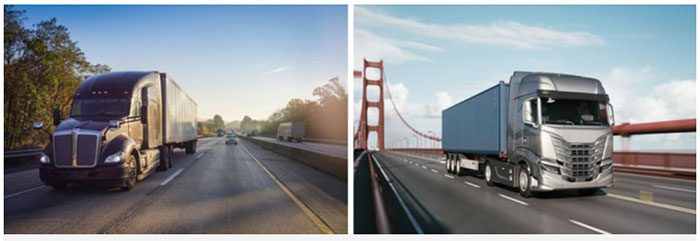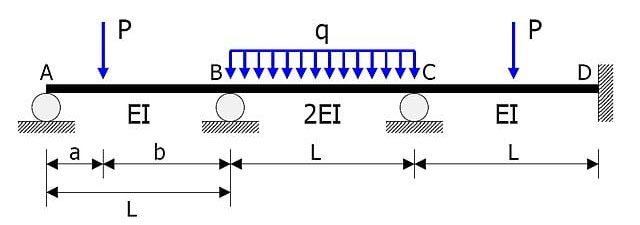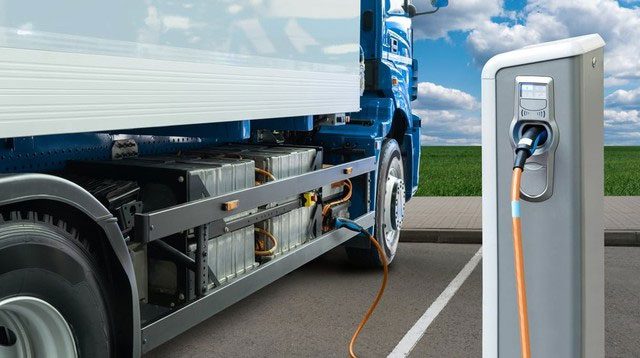Road transport is the backbone of the global supply chain. Whether goods are shipped by air or transported across seven seas, most will spend some time in the back of a truck before being delivered to your door.
It goes without saying that trucks are equipped with powerful engines, capable of traversing both favorable and challenging terrains to reach their destinations. As long as there is cargo to be delivered, there will be a truck available, regardless of the volume of goods that need transportation.
However, one question that piques the curiosity of many is why some trucks have a visible hood to house the engine while others have a flat “nose”?

Depending on the engine layout, trucks may have a protruding nose or simply appear flat.
Among the many ways to classify trucks, one method is classification by engine location. Most trucks in the U.S. typically have the engine located in front of the driver’s cabin. This results in them having a protruding hood that can be easily accessed for maintenance. Such trucks are referred to as “conventional trucks.”
On the other hand, most trucks in Europe often integrate the engine and the driver’s cabin into one unit. Consequently, these trucks will have a relatively flat front. To access the engine, the entire cabin can be moved to the side. These trucks are known as cab-over trucks.
Truck Design – Conventional Trucks vs. Cab-over Trucks
Conventional Trucks
According to the Federal Bridge Formula in the United States, trucks should have a heavy payload distributed across their axles. Since the axles must bear the total weight, distributing the load according to the formula requires the axles to be placed farther apart. For ergonomic purposes, the front axle must be positioned in front of the driver’s cabin. To achieve this, the engine must be mounted in front of the cabin, separated from it.

The protruding nose and longer wheelbase provide a spacious cabin for conventional truck drivers.
As a result, these trucks have quite spacious cabins that can accommodate various driver amenities.
Cab-over Trucks
The Federal Bridge Formula only exists in the U.S. and does not apply in Europe, meaning that the distance between the axles can be designed to be shorter. To achieve this, the engine and front axle are placed directly beneath the cabin seat. This area is often insulated from the heat and noise of the engine to avoid discomfort for the driver.

Cab-over trucks have smaller cabins but can carry loads equivalent to conventional trucks.
This results in a boxy cabin with a flat ‘nose’ or an engine compartment that is not visible. The cabin space for the driver is significantly reduced because the axles are placed closer together.
Design Significance and Its Impact on Road Transport
Conventional Design
The presence of a dedicated engine compartment allows for a greater distance between axles, and therefore a longer wheelbase. A longer wheelbase provides stability on straight roads but can significantly affect cornering. The comfort in the cabin of conventional trucks comes at the cost of limited visibility when turning, as this configuration creates blind spots for the driver.

The Federal Bridge Formula in the U.S. supports wider load distribution, leading to axles being placed farther apart.
Although no specific engine configuration is known to perform better than another while in motion, conventional trucks may face several disadvantages in collisions. A frontal collision can cause the engine to move inward, often crushing the driver sitting between it and the trailer, significantly reducing safety.

Conventional trucks have large blind spots and must rely on auxiliary mirrors to improve visibility.
Conventional trucks allow air to flow over their bodies more efficiently than cab-over trucks. Sloped and curved surfaces such as hoods, windshields, and cabs help reduce drag. This improves fuel efficiency, a crucial component in transportation costs.
Cab-over Design
Compared to conventional designs, cab-over trucks have shorter wheelbases and the driver’s position is higher. This makes maneuvering through tight spaces easier and provides excellent visibility for the driver. However, due to the lack of a dedicated engine compartment, the driver is subjected to higher temperatures, noise, and vibrations.
Since the engine is positioned beneath the driver, it will be pushed down and away in the event of an accident. Thus, the cab-over design is often considered safer. However, the boxy design increases the surface area that disrupts airflow. To counteract poor aerodynamics, cab-over trucks are often equipped with wind deflectors and curved roofs.
Applications
Due to their design, conventional trucks are often better suited for heavy-duty, long-haul jobs, such as mining, construction, and off-road use. In contrast, cab-over trucks are more suitable for lighter and moderately heavy tasks, mainly in urban areas and over shorter distances. Common applications include firefighting, waste collection, and parcel delivery.

Electrification and alternative fuel engines are the new direction for modern road transport.
While the differences in engine placement may seem minimal, they have a significant impact on truck performance. Advances in design and technology have come a long way since their inception, making them more compact yet more powerful than ever. Modern road transport is evolving towards alternative fuels and electrification. While it is reasonable for shorter distances, how suitable it is for long-haul road transport remains to be seen!




















































